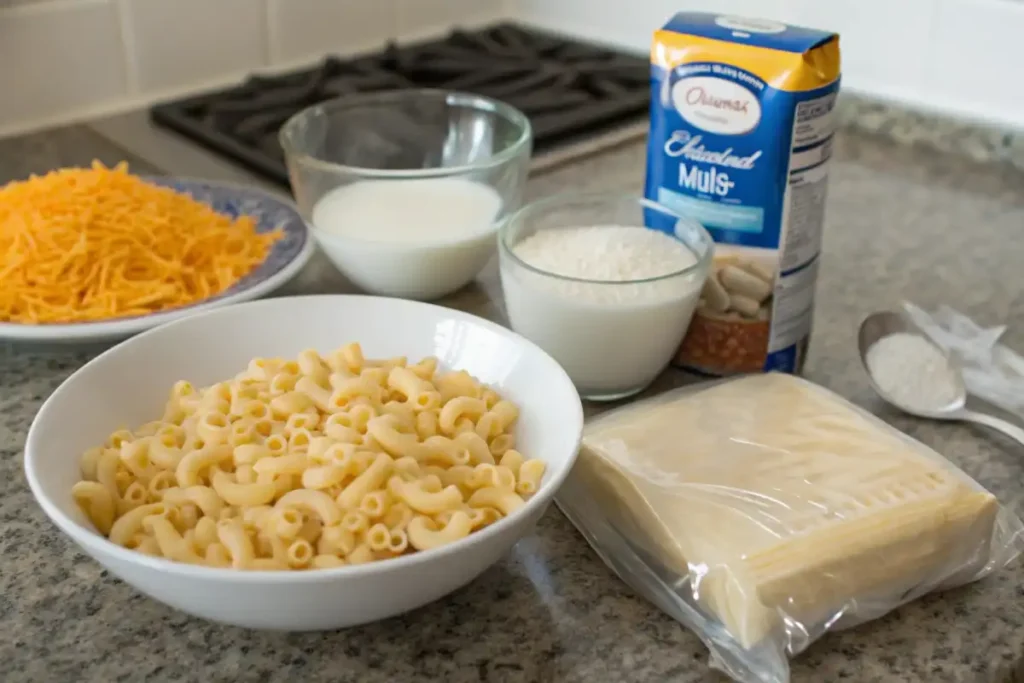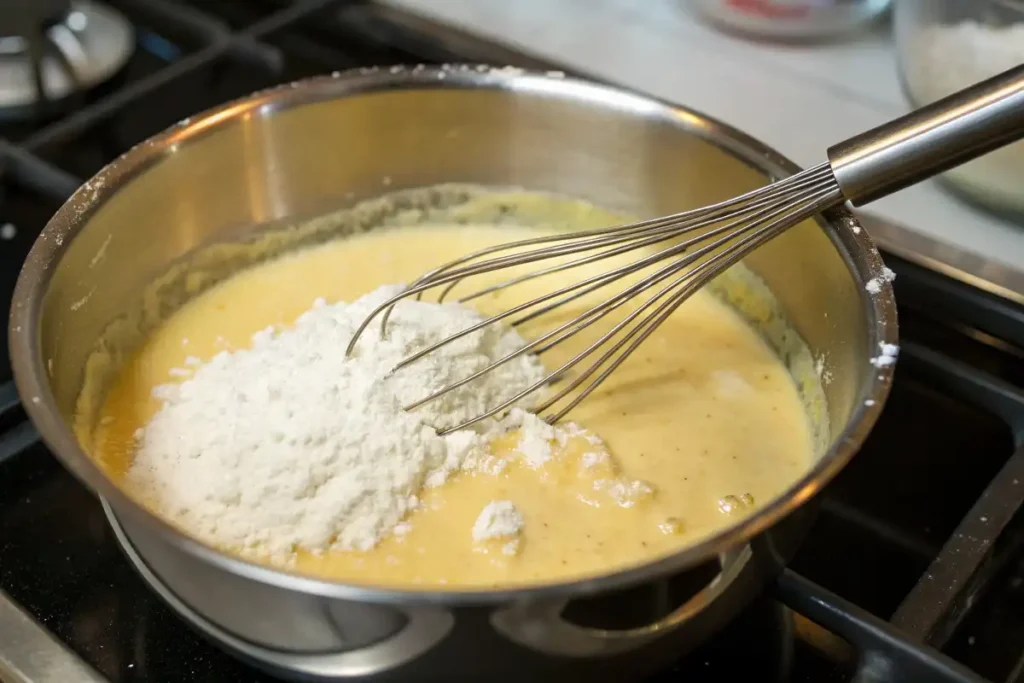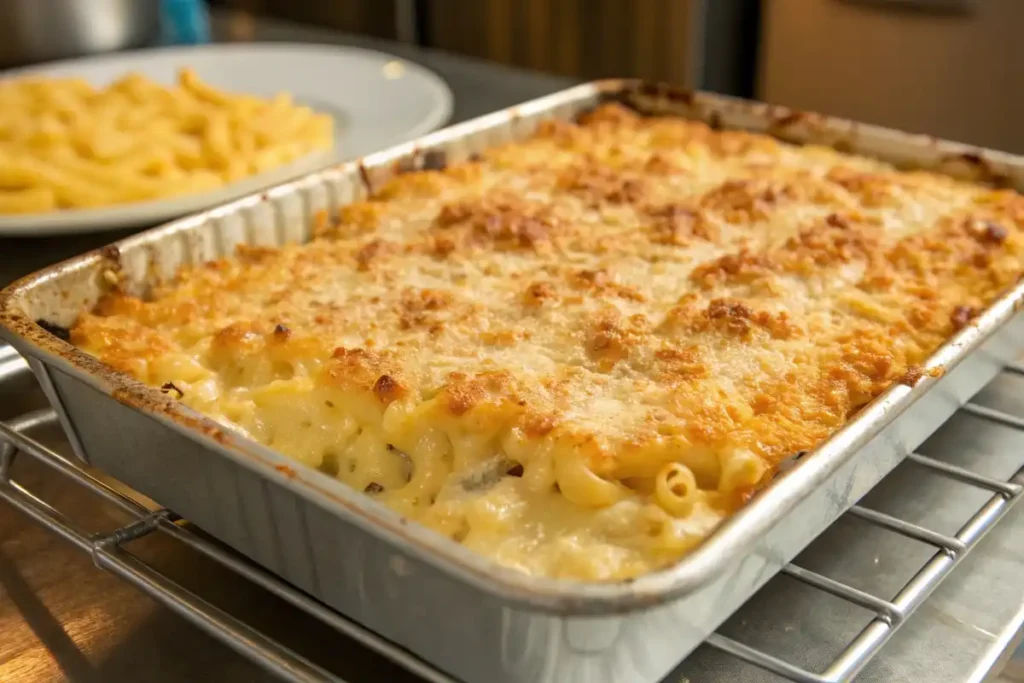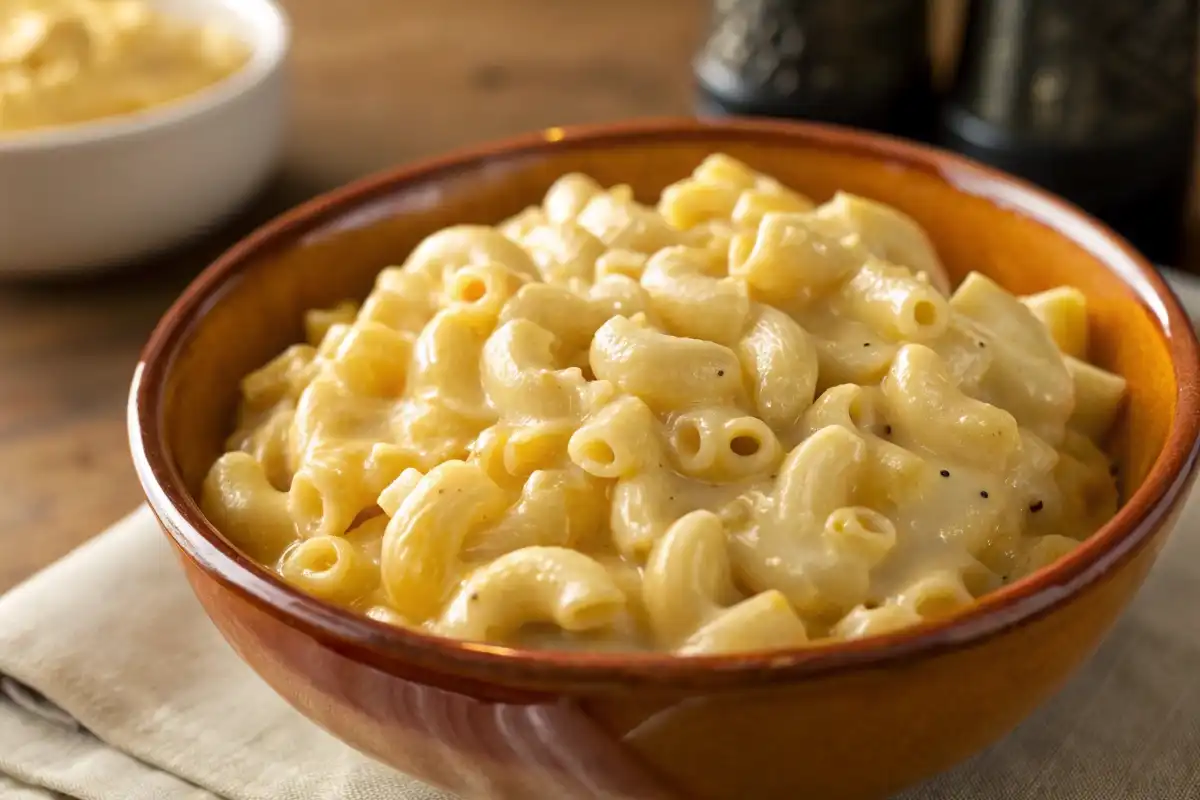Elevate your mac and cheese with evaporated milk for a velvety, comforting dish that’s easy to make and deeply satisfying.
Introduction
Macaroni and cheese is an enduring favorite that graces American dinner tables year-round. It’s beloved for its warmth, coziness, and nostalgic allure. Yet even a classic recipe can benefit from slight modifications that boost texture, flavor, and consistency. Many people ask, “Why use evaporated milk in mac and cheese?” because they notice how this pantry staple adds a silky finish and enhances the overall mouthfeel of the dish. In this article, we will explore the reasons evaporated milk shines in homemade mac and cheese, from its history and culinary science to practical recipe tips you can use immediately. Therefore, if you want your next bowl of pasta to be extra creamy and delicious, keep reading to uncover how evaporated milk can become your secret ingredient.
Table of Contents
A Brief History of Mac and Cheese
It’s easy to associate macaroni and cheese with modern times, yet its roots stretch back hundreds of years. In fact, variations of pasta with melted cheese trace back to Renaissance Europe, where dishes featuring butter, cream, and cheese sauces were popular among the aristocracy. However, today’s comforting casserole-style mac and cheese truly found its home in the United States.
From Europe to the American Table
Early American travelers and culinary enthusiasts brought pasta back from Italy, curious to replicate dishes they had tasted abroad. Thomas Jefferson, for example, is often credited with popularizing macaroni in the U.S. after returning from Europe. He served versions of pasta layered with cheese at social events, wowing dinner guests with the novelty of this dish. Over time, mac and cheese evolved to become a mainstay in American cooking, morphing from an elite curiosity to a family-friendly staple.
The Rise of Convenience
Although homemade versions flourished in American kitchens for generations, boxed macaroni and cheese found massive popularity in the mid-20th century. Consumers welcomed its affordability and ease. Yet, even with the convenience of pre-packaged options, many home cooks continue to cherish the richness and control that comes from making mac and cheese from scratch. As a result, questions such as “What is the best milk for mac and cheese?” or “Why use evaporated milk in mac and cheese?” naturally arise when exploring ways to improve or adapt family recipes.
For a classic approach to creating a bubbly, oven-finished pasta dish, check out Old-Fashioned Baked Macaroni and Cheese for more inspiration.
Understanding Evaporated Milk
When we say “evaporated milk,” we’re talking about a convenient canned dairy product that has had most of its water content removed through a gentle heating process. This technique makes it richer than regular milk, yet not as thick as heavy cream. Therefore, it resides in a special category of dairy that can greatly impact recipes like macaroni and cheese.
What Is Evaporated Milk Exactly?
During production, around 60% of the water in fresh milk is removed. Consequently, the result is a denser liquid that has an extended shelf life and a slightly sweet, toasty flavor. Because of its relatively low moisture content, evaporated milk yields a smoother consistency in sauces, making it less likely to curdle than regular milk when heated.
Nutritional Overview
In terms of nutrition, evaporated milk usually retains the same protein, vitamin, and mineral content as the original milk, only more concentrated. That means you’re getting beneficial nutrients in a smaller volume. This densified composition helps produce the indulgent mouthfeel in mac and cheese. However, it’s essential to note that brands may vary in their specific nutrient amounts.
Excellent for Cooking
One of the main reasons home cooks keep evaporated milk in their pantries is its versatility in savory and sweet dishes. It provides a velvety base for soups, casseroles, and, of course, mac and cheese. Meanwhile, its shelf stability makes it a convenient fallback on hectic days or whenever fresh dairy might be running low.
Why Use Evaporated Milk in Mac and Cheese?
Evaporated milk offers multiple advantages over ordinary milk in recipes that require smoothness and flavor. Therefore, understanding these benefits can help you decide if substituting it in your next batch of mac and cheese is the right choice.
Enhanced Creaminess
Because evaporated milk has already been reduced, it delivers a thicker, creamier consistency than standard milk. When you want your mac and cheese to be ultra-luxurious, you can add evaporated milk to the sauce. It holds up under heat, ensuring the sauce remains stable and easy to coat on your pasta.
Stable Sauce with Less Curdling
Another virtue of using evaporated milk is how well it pairs with cheese. When regular milk is heated, there’s always a risk of curdling, especially if you’re using high heat or combining multiple dairy products. However, the reduced water content in evaporated milk helps keep your cheese sauce unified. This translates to fewer lumps and a smoother result.
Subtle Sweetness That Complements Cheese
Cheese contains salt and a range of savory notes. Meanwhile, evaporated milk brings a mild, almost caramelized sweetness (due to the heating process that removes water). As a result, these flavors balance one another, often intensifying the cheese’s character without making the sauce sugary. In other words, evaporated milk nudges the taste of mac and cheese toward comforting richness.
Convenience and Shelf Life
If you find yourself making mac and cheese regularly, you may not always have fresh milk on hand. Evaporated milk solves that problem, as you can stock it in your pantry for months. Therefore, it’s perfect for last-minute meals or when grocery runs are sporadic.
Comparing Evaporated Milk to Other Dairy Choices
Some individuals rely on whole milk, half-and-half, or even heavy cream to achieve a creamy cheese sauce. However, evaporated milk stands out for specific reasons that appeal to home cooks seeking a balanced approach.
Whole Milk
Whole milk contains around 3.25% milk fat, providing a decent level of creaminess. However, it can be slightly thinner in sauce applications, so you may require additional cheese or flour to thicken the mixture. Regular milk also has a shorter shelf life than evaporated milk.
Half-and-Half and Heavy Cream
Although half-and-half and heavy cream are famously creamy, they contain significantly more fat. As a result, using them in large amounts can lead to a sauce that is too heavy or calorie-dense for some individuals. Evaporated milk, on the other hand, has a lower fat content than heavy cream, delivering a thick texture without overwhelming richness.
Plant-Based Milks
In certain recipes, individuals opt for soy, almond, or oat milk as dairy substitutes. While these can work in a vegan or lactose-avoidant version of mac and cheese, they usually lack the distinctive creamy mouthfeel of evaporated milk. For those not restricted by dietary requirements, evaporated milk still often yields more consistent results.
Where Evaporated Milk Excels
Ultimately, the question “Is evaporated milk better than milk for mac and cheese?” depends on your goals. If you want a stable sauce, slightly richer flavor, and reliable results, evaporated milk is typically a winning option. It’s a convenient middle ground between the lightness of whole milk and the heaviness of cream.
Step-by-Step Recipe: Creamy Mac and Cheese with Evaporated Milk
If you’re ready to experience firsthand why evaporated milk works wonders in mac and cheese, this recipe will guide you. It’s a straightforward approach that yields a luscious, homestyle dish every time.
Ingredients (for 6 servings)

- 2 cups elbow macaroni (or similar small pasta)
- 2 tablespoons unsalted butter
- 2 tablespoons all-purpose flour
- 1½ cups evaporated milk
- 2 cups shredded cheddar cheese (sharper varieties work best)
- ½ teaspoon salt (adjust to taste)
- ¼ teaspoon black pepper
- ¼ teaspoon onion powder (optional)
- ¼ teaspoon mustard powder (optional)
- Pinch of paprika (optional, for color and subtle smokiness)
Cooking Instructions

- Boil the Pasta
- Fill a large pot with water.
- Bring the water to a boil, then add a generous pinch of salt.
- Stir in the elbow macaroni and cook until al dente (about 7–8 minutes).
- Drain and set aside.
- Tip: Slightly undercook the pasta to prevent mushiness when you later combine it with the cheese sauce.
- Prepare the Roux
- Meanwhile, melt the butter in a saucepan over medium heat.
- Once melted, whisk in the flour to form a roux.
- Stir constantly for 1–2 minutes to prevent lumps.
- Avoid browning the roux as you want a light, golden base.
- Incorporate Evaporated Milk
- Gradually pour in the evaporated milk, whisking consistently.
- Increase the heat slightly and continue stirring until the sauce thickens, around 3–4 minutes.
- This step is critical for achieving the creamy sauce mac and cheese lovers crave.
- Add Cheese and Seasonings
- Reduce the heat to low.
- Stir in the shredded cheddar cheese a handful at a time, letting each portion melt before adding the next.
- Mix in salt, pepper, onion powder, and mustard powder if desired.
- Taste-test and adjust seasonings as needed. If you want an extra kick of color, sprinkle in some paprika.
- Combine Pasta and Sauce
- Toss the cooked macaroni into the cheese sauce, ensuring each piece is well coated.
- If the sauce seems too thick, add a splash of milk or a bit more evaporated milk. If it’s too thin, gently simmer until it reaches the right consistency.
- Optional Baking Step
- You can serve this dish straight from the stovetop or bake it for a bubbly crust.
- To bake, preheat your oven to 350°F (175°C). Transfer the mac and cheese to a lightly greased baking dish. Top with extra shredded cheese and bake uncovered for about 20 minutes, or until golden and bubbly.
- Wondering if you should cover your mac and cheese? Check out our in-depth take on Are you supposed to cover macaroni and cheese when you bake it?
- Serve and Enjoy
- Let the dish rest for a couple of minutes before serving. This allows the sauce to settle and prevents burning tongues.
- Relish the satisfaction of a perfectly creamy meal and share it with family or friends!

Nutritional Information
Below is the approximate nutritional breakdown per 100g of the prepared mac and cheese with evaporated milk.
| Nutrient | Approx. Value per 100g |
|---|---|
| Calories | ~220 kcal |
| Carbohydrates | ~20 g |
| Protein | ~9 g |
| Total Fat | ~12 g |
| Saturated Fat | ~7 g |
| Cholesterol | ~30 mg |
| Sodium | ~320 mg |
| Fiber | ~1 g |
| Calcium | ~180 mg |
Note: Actual values may vary slightly based on specific cheese brands and measurement accuracy.
Flavor Variations and Tips for Using Evaporated Milk
Evaporated milk is an adaptable ingredient that can open doors to creative mac and cheese renditions. Therefore, don’t be afraid to experiment with new ideas.
Add Herbs and Spices
A sprinkle of paprika or chili powder can transform the flavor profile. Alternatively, fresh herbs like thyme or parsley bring a bright taste to an otherwise rich dish. You might also blend in a little garlic powder for extra depth.
Mix In Vegetables and Proteins
If you’re looking to increase the nutritional value, add steamed broccoli, roasted bell peppers, or spinach. Although traditional mac and cheese is prized for its simplicity, extra vegetables never hurt—just be sure not to let them overshadow the creamy sauce.
Adjusting the Sauce Texture
- Thicker Sauce: Add a small amount of extra grated cheese or a half tablespoon of flour to your roux.
- Thinner Sauce: Introduce more evaporated milk or a small splash of regular milk until you find your desired consistency.
Avoid Common Pitfalls
- Overcooking the Pasta: Undercook by a minute or two before merging with your sauce to keep pasta from turning mushy.
- Using Low-Quality Cheese: Shred your own cheese for best melting results. Pre-shredded cheese often contains anti-caking agents that can affect smoothness.
- Skipping Roux Steps: A rushed roux can lead to a grainy, uneven sauce. Therefore, take your time whisking.
If you’re new to cheese melting techniques, you might also enjoy our article on Does Cottage Cheese Melt Like Cheese?.
Additional Uses for Evaporated Milk
Although our main question is “Why use evaporated milk in mac and cheese?” the versatility of this ingredient goes beyond pasta dishes. Therefore, you might find it useful for many other recipes as well.
Creamy Sauces and Gratins
Evaporated milk is excellent for enhancing savory pies, casseroles, or vegetable gratins. For instance, it yields a rich sauce for scalloped potatoes without the heaviness of cream.
Soups and Stews
Add evaporated milk to tomato soup or chowders for an immediate creamy boost. This technique can help you create a comforting meal while lowering the risk of curdling.
Baked Goods and Desserts
In sweet treats, evaporated milk can act as a liquid ingredient that locks in moisture. While it is distinct from condensed milk (which contains added sugar), evaporated milk still contributes a mellow sweetness to flans, puddings, or even pies.
Frequently Asked Questions
Is evaporated milk better than milk for mac and cheese?
Many cooks believe that evaporated milk is indeed better for mac and cheese. It produces a creamier sauce and lowers the risk of curdling compared to regular milk. Moreover, the flavor becomes richer due to its concentrated nature. However, personal preference will always play a part, so try both options to see which you prefer.
What is the trick to keeping mac and cheese creamy?
A few strategies keep mac and cheese creamy: use a roux to stabilize the sauce, opt for evaporated milk to minimize moisture loss, and add cheese gradually. Undercooking your pasta slightly also prevents it from absorbing too much sauce, thereby preserving creaminess.
What does evaporated milk do to cheese?
Evaporated milk helps cheese melt smoothly by balancing the ratio of fats and proteins. Because its reduced water content hinders rapid separation, you get fewer clumps and a more uniform texture. The end result is a cohesive, luscious sauce that is less prone to break or form lumps.
What is the best milk for mac and cheese?
It depends on your taste and nutritional goals. Whole milk provides a decent level of creaminess, heavy cream offers maximum richness, and evaporated milk strikes a balance between the two. If you value stability, flavor intensity, and convenience, evaporated milk is often considered the best choice.
Conclusion
Why use evaporated milk in mac and cheese? The answer lies in its ability to bring thick, velvety texture, a stable sauce, and a mellow sweetness that complements cheese perfectly. In addition, it’s easier to store than fresh dairy and gives you consistent results every time. Therefore, whether you’re making a quick stovetop version or baking a big casserole, consider incorporating evaporated milk into your next batch of macaroni and cheese. By doing so, you’ll discover how a simple pantry ingredient can take a familiar comfort food to new heights. Enjoy experimenting with different cheese blends, vegetables, or seasonings, and see how evaporated milk becomes your new secret weapon for a memorable meal.

